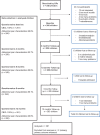The course of mental health problems in children presenting with abdominal pain in general practice
- PMID: 22643157
- PMCID: PMC3378001
- DOI: 10.3109/02813432.2012.675561
The course of mental health problems in children presenting with abdominal pain in general practice
Abstract
Objective: To investigate the course of mental health problems in children presenting to general practice with abdominal pain and to evaluate the extent to which abdominal pain characteristics during follow-up predict the presence of mental health problems at 12 months' follow-up.
Design: A prospective cohort study with one-year follow-up.
Setting: 53 general practices in the Netherlands, between May 2004 and March 2006.
Subjects: 281 children aged 4-17 years.
Main outcome measures: The presence of a depressive problem, an anxiety problem, and multiple non-specific somatic symptoms at follow-up and odds ratios of duration, frequency, and severity of abdominal pain with these mental health problems at follow-up.
Results: A depressive problem persisted in 24/74 children (32.9%; 95% CI 22.3-44.9%), an anxiety problem in 13/43 (30.2%; 95% CI 17.2-46.1%) and the presence of multiple non-specific somatic symptoms in 75/170 children (44.1%; 95% CI 36.7-51.6%). None of the abdominal pain characteristics predicted a depressive or an anxiety problem at 12 months' follow-up. More moments of moderate to severe abdominal pain predicted the presence of multiple non-specific somatic symptoms at follow-up.
Conclusions: In one-third of the children presenting to general practice for abdominal pain, anxiety and depressive problems persist during one year of follow-up. Characteristics of the abdominal pain during the follow-up period do not predict anxiety or depressive problems after one-year follow-up. We recommend following over time children seen in primary care with abdominal pain.
Figures
References
-
- Chitkara DK, Rawat DJ, Talley NJ. The epidemiology of childhood recurrent abdominal pain in Western countries: A systematic review. Am J Gastroenterol. 2005;100:1868–75. - PubMed
-
- Perquin CW, Hazebroek-Kampschreur AA, Hunfeld JA, Bohnen AM, van Suijlekom-Smit LW, Passchier J, et al. Pain in children and adolescents: A common experience. Pain. 2000;87:51–8. - PubMed
-
- Stordal K, Nygaard EA, Bentsen BS. Organic abnormalities in recurrent abdominal pain in children. Acta Paediatr. 2001;90:638–42. - PubMed
-
- Gieteling MJ, Bierma-Zeinstra SMA, Passchier J, Berger MY. Prognosis of chronic or recurrent abdominal pain in children. J Pediatr Gastroenterol Nutr. 2008;47:316–26. - PubMed
MeSH terms
LinkOut - more resources
Full Text Sources
Medical


